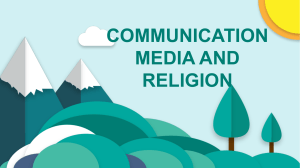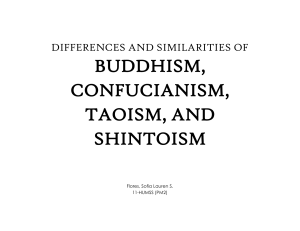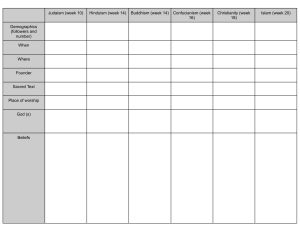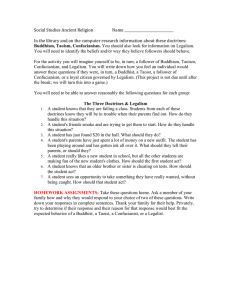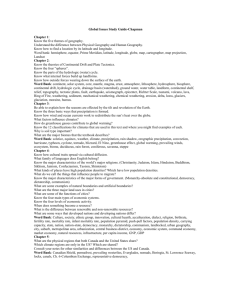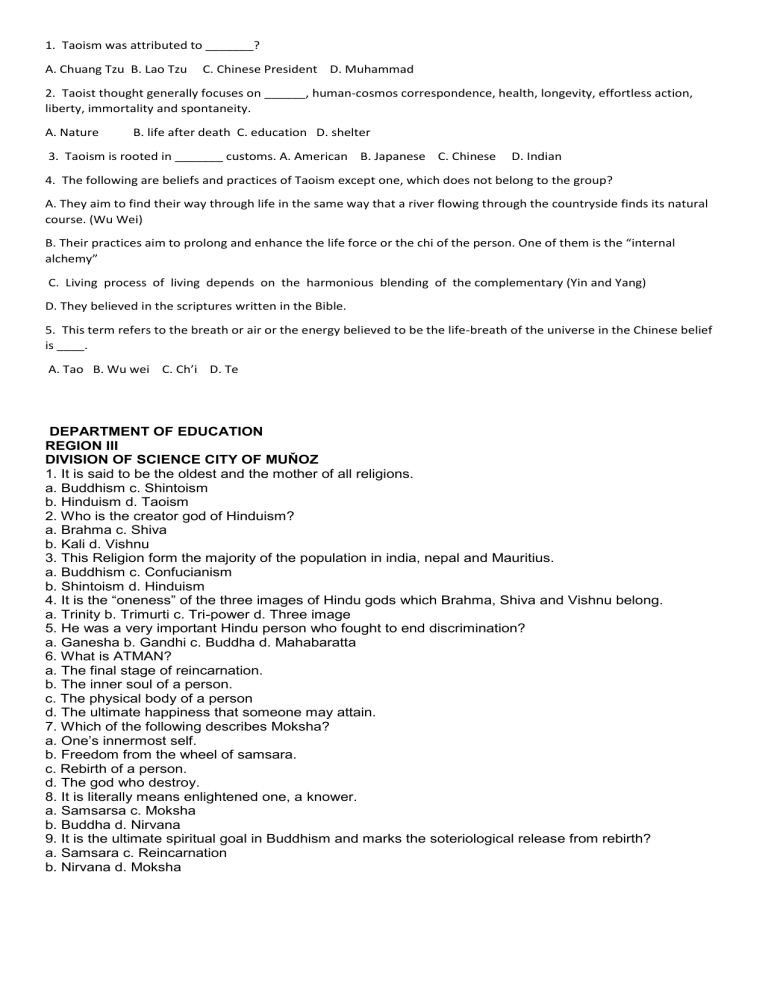
1. Taoism was attributed to _______? A. Chuang Tzu B. Lao Tzu C. Chinese President D. Muhammad 2. Taoist thought generally focuses on ______, human-cosmos correspondence, health, longevity, effortless action, liberty, immortality and spontaneity. A. Nature B. life after death C. education D. shelter 3. Taoism is rooted in _______ customs. A. American B. Japanese C. Chinese D. Indian 4. The following are beliefs and practices of Taoism except one, which does not belong to the group? A. They aim to find their way through life in the same way that a river flowing through the countryside finds its natural course. (Wu Wei) B. Their practices aim to prolong and enhance the life force or the chi of the person. One of them is the “internal alchemy” C. Living process of living depends on the harmonious blending of the complementary (Yin and Yang) D. They believed in the scriptures written in the Bible. 5. This term refers to the breath or air or the energy believed to be the life-breath of the universe in the Chinese belief is ____. A. Tao B. Wu wei C. Ch’i D. Te DEPARTMENT OF EDUCATION REGION III DIVISION OF SCIENCE CITY OF MUŇOZ 1. It is said to be the oldest and the mother of all religions. a. Buddhism c. Shintoism b. Hinduism d. Taoism 2. Who is the creator god of Hinduism? a. Brahma c. Shiva b. Kali d. Vishnu 3. This Religion form the majority of the population in india, nepal and Mauritius. a. Buddhism c. Confucianism b. Shintoism d. Hinduism 4. It is the “oneness” of the three images of Hindu gods which Brahma, Shiva and Vishnu belong. a. Trinity b. Trimurti c. Tri-power d. Three image 5. He was a very important Hindu person who fought to end discrimination? a. Ganesha b. Gandhi c. Buddha d. Mahabaratta 6. What is ATMAN? a. The final stage of reincarnation. b. The inner soul of a person. c. The physical body of a person d. The ultimate happiness that someone may attain. 7. Which of the following describes Moksha? a. One’s innermost self. b. Freedom from the wheel of samsara. c. Rebirth of a person. d. The god who destroy. 8. It is literally means enlightened one, a knower. a. Samsarsa c. Moksha b. Buddha d. Nirvana 9. It is the ultimate spiritual goal in Buddhism and marks the soteriological release from rebirth? a. Samsara c. Reincarnation b. Nirvana d. Moksha 10. What are the missing words in the Four Noble Truths: Life is ______________, Suffering is due to_________________, There is way to overcome ________________, The way to overcome craving is the _______________. a. Blessing, selfishness, selfishness, meditation b. Given by Brahman, craving, death, wisdom c. Suffering, craving, craving, eight fold path d.Wonderful, mistakes, failure, four noble truth 11. According to Buddhist teaching, it is an ideal state of intellectual and ethical perfection which can be achieved by man through purely human means. a. Wisdom c. Enlightens b. Knowledge d. Encouragement 12. Which division of Buddhism believed that a Buddhist must strictly follow the teachings of the Buddha? a. Mahayana Buddhism c. Theravada Buddhism b. Hindu Buddhism d. Zen Buddhism 13. The liberal form of Buddhism which believed that not all the truth in the world was taught by the Buddha. a. Mahayana Buddhism c. Hindu Buddhism b. Theravada Buddhism d. Zen Buddhism 14. Which of the following is true about Buddhist teachings? a. A Buddhist must worship all the Indian gods. b. If someone want to be a Buddhist, he must give up his belief in any god. c. One can attain Nirvana if he will live simply and out of any material desires. d. Suffering is due to poverty. 15. Choose from the following statements that described the doctrine of Mahayana Buddhism. a. A member must wear orange robe. b. A member must live in a Shangha. c. A member is allowed to live a usual life. d. A member must strictly follow the teachings of the Buddha. 16. Which believe that nothing is fixed or permanent and that change is always possible. a. Shintoist c. Confucians b. Buddhist d. Taoist 17. Which of the following shows similarities of Hinduism and Buddhism? a. Believe in the samsara/reincarnation. b. Believe in Four Noble Truth. c. Founded by Siddhartha Gautama. d. Worship many gods. 18. Chinese name of the founder of Confucianism. a. Kung Fu c Lao Tzu b. Kung Fu Tzu d. Siddhartha Gautama 19. Which of the following describes background of Confucius? a. He was born in a minor aristocratic family. b. He studies was through a village tutor. c. He worked as a manager and bookkeeper at a young age. d. All of the above. 20. This is the fundamental concern of the Confucian tradition? a. Learning to be human. b. Right belief over right action c. Learning to do right d. Right practice and right doctrine 21. It is often characterized as a system of social and ethical philosophy rather than a religion.? a. Taoism c. Hinduism b. Confucianism d. Buddhist 22. It means Enlightened One. a. Buddhism c. Buddha b. Boddhisatva d. Buddhi 23. Social teaching of Confucius focused on the__________________. a. Being an obedient citizen to the laws. b. Class and caste system. c. Discipline among all the members of society. d. Proper behaviour of the individual in society and to his fellow men. 24. Political teachings of Confucius focused on the ____________. a. Maintainance of the power of the ruler. b. People’s obedience with the authority. c. The art of governance and the proper relationship of the Ruler to the ruled. d. The need of the mass. 25. What is the view of Confucius about education? a. All citizens must be educated. b. Central way to achieving proper conduct both within Society and in Government. c. It is the way for a person to become a good and productive citizens of the society. d. The government must provide a good education to all the children of the society. 26. This is the book where the teachings of Confucius was written. a. Analects b. Tripitaka c. Qur’an d. Vedas 27. According to Confucius, why does people become bad? a. By the influence of demons. b. Because of poor and bad leadership. c. Because of their desires. d. Having no education. 28. It is a philosophy about the proper path in life. a. Taoism c. Confucianism b. Daoism d. Shintoism 29. It is a Chinese philosophy based on the teachings of Lao Tzu. a. Shintoism b. Taoism c. Daoism d. Confucianism 30. It is a religious or philosophical tradition of Chinese origin which emphasizes living in harmony with the Tao. a. Buddhism c. Taoism b. Confucianism d. Shintoism 31. How does Taoism differ from the Confucianism? a. Taoism do not emphasizing rigid rituals and social order. b. Taoism has its own gods. c. Taoism is more focused on worshiping. d. There is no difference between Taoism and Confucianism. 32. What is Yinyang? a. Being one with the nature. b. Being free in any material desires. c. Balance in everything. d. Sign of evil in Chinese belief. 33. Which of the following is true about Tao. a. Flow of the universe c. Road, path or way b. Has variety of meaning d. All of the above 34. Who are the two main gods in “The Kojiki Story of Creation?” a. Izanagi and Izanami c. Shin and To b. Kojiki and Kojiko d. Yomi and Kuni 35. It is a fundamental text for both philosophical and religious Taoism a. Tao Te Ching c. Tsong Kayla b. Lao Tzu d. Arigato 36. Which of the following is true about Shintoism? a. It is still the dominant religion in Japan. b. It is founded by Lao Tzu c. It is monotheist religion d. Only few Japanese are member of Shintoism nowadays. 37. What is Kami? a. Supreme god in Shintoism. b. The spirits or spiritual essence in everything. c. Place of worship. d. Religious leader in Shintoism. 38. Why does Shintoism considered as animistic religion? a. Because they worship animals as their gods. b. Because they believed that everything has spirits or soul. c. Because they only have one god. d. Because they have many gods. 39. Why does Shinto members worship ancestors and forces of nature? a. To achieve harmony in all dimensions. b. To forgive their sins. c. To have prosperous life. d. To have good luck. 40. What are considered sacred texts of Shintoism? a. Izanagi and Izanami c. Shin and To b. Kojiki and Nihongi d. Yomi and Kuni 41. They believed that everything is interconnected in life. a. Hindus c. Arab b. Shintos d. Taoist 42. Who is the most prominent and famous of the Shinto gods or kami? a. Amaterasu c. Izanagi b. Izanami d. Yomi 43. The Sun Goddess who was born from the left eye socket of a male creator kami named Izanagi. a. Amaterasu c. Izanagi b. Izanami d. Yomi 44. Why the Tokugawa military governor does denounced and outlawed the practice of foreign religion such as Christianity? a. Because Japanese are anti- Christ. b. Because they perceived the foreign religions as corrupting influence. c. Because the Tokugawa military is an atheist group. d. Because it may overpower the Shintoism belief. 45. Which of the following shows similarities of the Confucianism and Taoism? Both believe in spirits Both flourished in China. Both political Both believe in immortality 46. A person is praying in the clouds and asking not to give them super typhoon. In which religion do you think this person belongs? a. Buddhism c. Shintoism b. Confucianism d. Taoism 47. Which of the following religions sought to answer social problems? a. Buddhism c. Taoism b. Confucianism d. All of the above 48. Choose from the following statements that shows similarities of the Shintoism and Taoism. a. Both are Philosophies and not religions. b. Founded by Lao Tzu c. Have a high respect for nature. d. Monotheistic religion 49. This Religion emphasized the importance of nature and their ancestors. a. Confucianism c. Taoism b. Shintoism d. All of the above 50. Why Buddhists does practiced martial arts despite of their belief in non-violence? Because they have to defend their temple against group condemning them. Because of their enemies. This is one of their new teachings. This is their way of meditating
